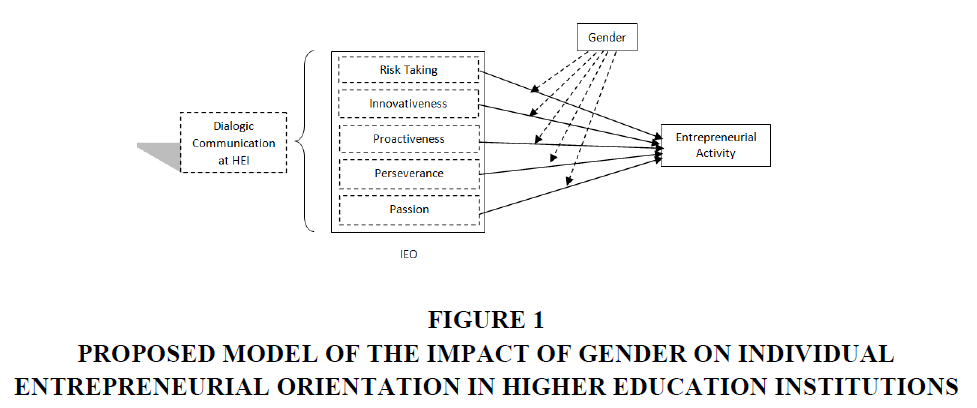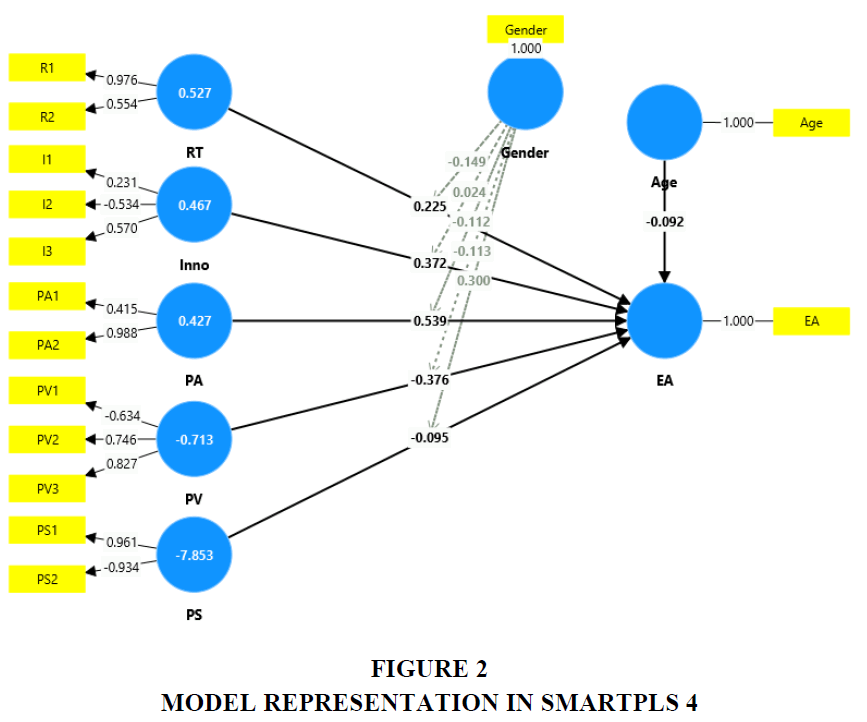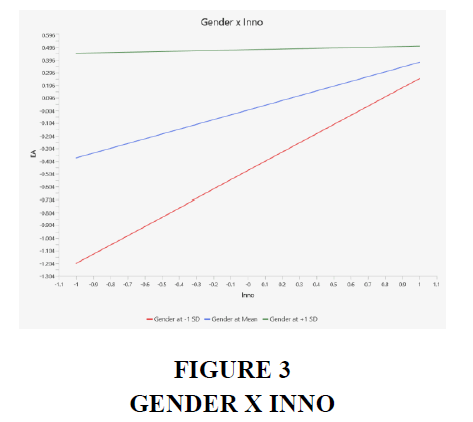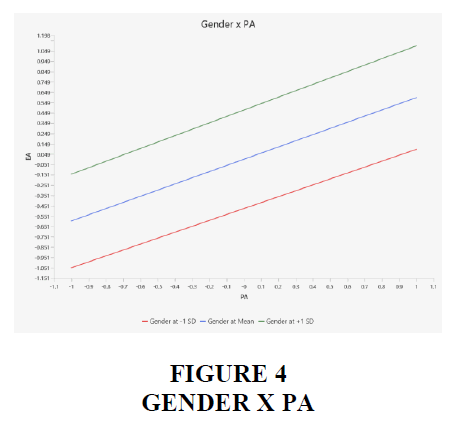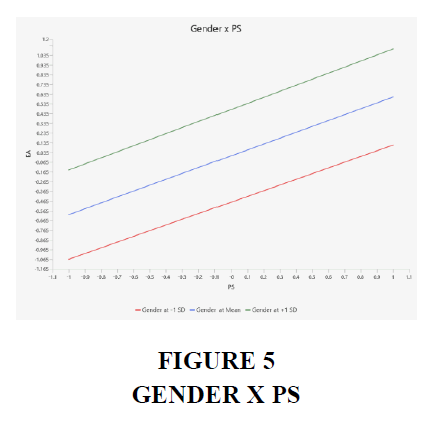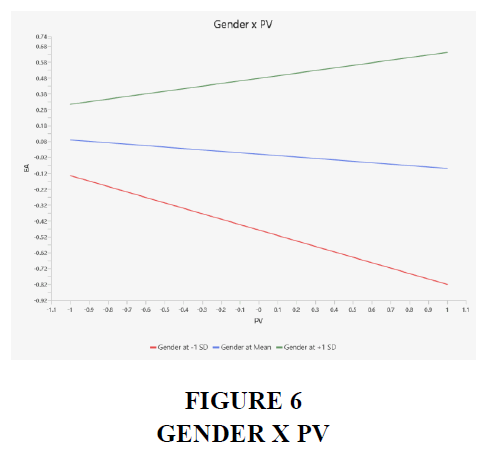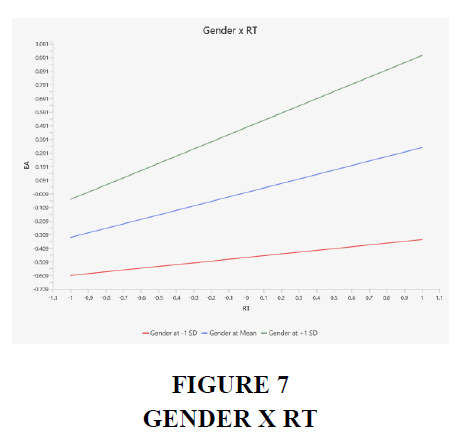Research Article: 2024 Vol: 28 Issue: 5
Development of Individual Entrepreneurial Orientation In Higher Education Institutes: A Gender Moderated Dialogic Communication Perspective
Puja Agarwal, Management Development Institute, Gurgaon
Paramjit S. Lamba, Management Development Institute, Gurgaon
Neera Jain, Management Development Institute, Gurgaon
Citation Information: Agarwal, P., Lamba, P.S., & Jain, N. (2024). “Development of individual entrepreneurial orientation in higher education institutes:: a gender moderated dialogic communication perspective". Academy of Marketing Studies Journal, 28(5), 1-15.
Abstract
Purpose: This study, aligning with the future research suggestions of Paray and Kumar (2020) and Ramadani et al. (2022), aims to examine the impact of gender on the development of entrepreneurial orientation and its further translation into entrepreneurial activity among students in higher education institutions, particularly those pursuing management degrees. Design/methodology/approach: Data from 312 respondents studying in higher education institutes was analyzed. After establishing discriminant validity, Smart PLS4 was used to conduct slope analysis to understand the moderating effect of gender on the relationship between the individual constructs of the 5 dimensional individual entrepreneurial orientation. Findings: Higher education institutions have a significant influence on developing entrepreneurial orientation and individual entrepreneurial orientation has a significant impact on entrepreneurial activity (EA). Gender has a significant moderating influence on risk-taking, perseverance, and innovativeness, while it remains positive for passion and proactiveness irrespective of gender. In male students, the risk taking and perseverance constructs have a significantly positive influence on EA, while in the case of female students, the positive influence of Innovativeness is amplified. Gender has no impact on the relationship between passion or proactiveness and entrepreneurial activity. Originality/value: This study sheds new light on risk taking, innovativeness, proactiveness, perseverance, and passion, which are individual constructs of the revised entrepreneurial orientation scale within the context of higher education institutions, and the moderating effect of gender on these constructs. This study can help HEI administrators in allocating resources, and formulating effective policies for fostering entrepreneurial orientation among students.
Keywords
Entrepreneurial Orientation, Higher Education Institute, Gender moderation, Entrepreneurial activity, Slope Analysis
Introduction
Higher Education Institutions (HEIs) play a key part in nurturing an entrepreneurial mindset by providing key courses in innovation and entrepreneurship. The conventional method of teaching innovation and entrepreneurship aims to inspire an entrepreneurial orientation that can lead to the creation of new startups. However, higher education, especially in the context of innovation and entrepreneurship courses, extends beyond just fostering new startups. While the establishment of new startups is frequently used as a primary metric for gauging economic growth, particularly in terms of entrepreneurial activities at both national and regional levels (Szerb and Acs, 2011), the scope of such education encompasses a broader spectrum of endeavors beyond new startup ventures.
Boosting entrepreneurial activities has always been key to achieving a country's socio-economic development and growth objectives. Existing literature indicates that traditional teaching methods in higher education tend to take an "about" approach, focusing on imparting theoretical knowledge (Pittaway and Edwards, 2012) and often lack an applied methodological approach that involves actively engaging students and exposing them to solution focused learning and design thinking which is imperative for entrepreneurship (Neck and Greene, 2011). The underlying idea is to revamp and reshape the higher education system to enable participants to understand and grasp the entrepreneurial nuances. Entrepreneurship itself entails taking actions and gaining experiential learning that involves out of the box thinking, conceptualization, opportunity reasoning, resilience, and navigating volatility within institutional frameworks. Conventional methods, often rooted in a linear problem-solving approach, fall short in providing the necessary tools to enhance their context oriented grasp of entrepreneurship (Neck and Greene, 2011).
When contemplating the realm of entrepreneurship and management graduates, several inquiries arise: Are these graduates inclined towards entrepreneurship during their academic journey? Have they been acquainted with the intricacies of launching their own business? What factors guide them in this direction?
The decision to embark on a new business venture is deeply personal and hinges on an individual's orientation, ambition, motivation, and circumstances. Establishing a new business occurs within the framework of societal values and business environments. This entrepreneurial milieu can significantly impact the prospects of a new venture.
This study responds to the call given by Paray and Kumar (2020) and Ramadani et al. (2022). Given the pivotal role of entrepreneurship in driving economic growth and development, it becomes imperative to uncover the factors that either foster or hinder entrepreneurial endeavors. For instance, individual-level factors such as risk tolerance, educational background, professional experience, age, and alternative job opportunities may influence one's decision to pursue entrepreneurship (Cuervo, 2005).
Role of Higher Education Institutions
Higher education has the potential to enhance students' knowledge, skills, and aspirations to launch their businesses (Ahmed et al., 2017; Fietze and Boyd, 2017; Garrido-Lopez et al., 2018). HEIs play a key role in nurturing entrepreneurship. Specifically, management and engineering clusters within HEIs should serve as platforms where students can explore their proclivity toward research and cultivate new ideas (Ramadani et al., 2022). Cui (2021) highlighted that entrepreneurship education (EE) positively influences the mindset, attitudes, and behaviors of young individuals towards choosing entrepreneurship as a career path. EE also contributes to enhancing a country's entrepreneurial landscape, potentially addressing socio-economic challenges such as low employment, penury, and dismal quality of life. By aiming to reshape the outlook of students related to risk and innovation associated with entrepreneurial endeavors, EE stands as one of the most crucial human capital assets that can cultivate a more entrepreneurship-oriented society (Bhat & Singh, 2018; Jones et al., 2014). Despite an expanding corpus of evidence demonstrating that entrepreneurship has the potential to enhance community income and well-being in developing nations through the creation of new employment opportunities (Linan and Fayolle, 2015) and economic prosperity as highlighted by Mukhtar et al. (2021), scholars affiliated with institutions of higher education in developing countries have thus far not directed their attention towards this crucial subject matter.
Entrepreneurship and Women
The phenomenon of entrepreneurship among women serves as a mechanism to mitigate social and economic disparities. The sector of women-owned businesses is increasingly viewed as a burgeoning domain of entrepreneurship, contributing significantly to economic and social advancement by fostering innovation, generating wealth, alleviating poverty, intensifying competition, promoting business diversity, and harnessing untapped human resources. Nevertheless, despite the potential associated with female entrepreneurship, substantial gender disparities persist among male and female entrepreneurs. Women are often found to be engaged in industries with limited growth potential, and their entrepreneurial endeavors frequently encounter obstacles such as financial constraints, challenges in balancing work and family responsibilities, conflicts in roles, societal and cultural stereotypes, and a lack of supportive institutional frameworks. Scholarly literature demonstrates that the entrepreneurial activities of women are greatly influenced by the social, cultural, and institutional milieu of a given country. The prevailing culture and traditions play a pivotal role in shaping the perceptions of society toward women participating in the workforce. These societal and cultural norms can sometimes act as impediments for female entrepreneurs, thereby restricting the growth of women-owned enterprises to predominantly micro-enterprises.
Gender plays a significant role in shaping entrepreneurial orientation (EO) due to its sociocultural implications. Despite a gradual increase in women entrepreneurs, research indicates that they are still less likely than men to embark on entrepreneurial ventures and initiate new businesses (García, 2017; Garcia and Contreras, 2014). Various factors contribute to the challenges women face in starting businesses. For instance, gender-based societal norms in certain regions portray entrepreneurship as predominantly a male domain, limiting opportunities for women to pursue entrepreneurial endeavors (Verheul et al., 2012). Additionally, cultural and institutional barriers, as highlighted by Dana & Dana (2005) may deter women from choosing entrepreneurship and impede their business success. A study conducted by the Global Entrepreneurship Monitor (2020) further supports these findings, indicating that women in Southeast Asia can enhance their quality of life by engaging in activities such as learning new technologies to explore business opportunities, fostering business innovation, and improving social media skills.
Researchers universally acknowledge the significance of women entrepreneurs in catalyzing social and economic transformations; however, the domain of women entrepreneurship remains inadequately explored within the realm of entrepreneurship, particularly in emerging economies (Brush, et al., 2009). Delving into research within emerging economies has the potential to enrich the foundation of theoretical frameworks in the entrepreneurship literature. Ahl (2006) highlights that the field of female entrepreneurship has been hindered by a dearth of novel theoretical underpinnings. The recent spotlight on female entrepreneurship is grounded in the recognition of the diverse business landscape as a driver of economic progress and national development. This trend not only spurs job creation but also fosters self-fulfillment among women, contributing to the diversification of entrepreneurial endeavors within the system. Several empirical investigations have underscored the presence of a gender disparity in entrepreneurial engagements.
Literature Review
The contribution of entrepreneurship to economic development has been studied extensively (Baumol et al., 2007; Koellinger and Thurik, 2012). In India, however, empirical studies related to entrepreneurship have a potential for growth. Along with behavior, education is strongly correlated with the orientation to start a venture.
Individual Entrepreneurial Orientation
EO has come up as a central focus within the field of entrepreneurship research (Covin and Lumpkin, 2011; Ferreira et al., 2019). The theoretical framework of individual entrepreneurial orientation (IEO) is based on the potential of entrepreneurs to act as valuable economic resources through the application of their entrepreneurial skills in recognizing, pursuing, and efficiently exploiting feasible business prospects. Kollmann et al. (2007) developed this conceptual framework within the context of budding entrepreneurs, exploring the relationship between IEO and environmental factors such as cultural, political-legal, macro, and microeconomic conditions. These authors also highlight that pre-nascent entrepreneurs encounter various environmental influences at the outset of the entrepreneurial process.
As per Bolton and Lane (2012), and Joardar and Wu (2011), the EO construct holds significance as an individual phenomenon. Thus, IEO is conceptualized as a comprehensive evaluation of individuals' inclination toward entrepreneurship (Basso et al., 2009). Entrepreneurial Orientation generates interest in literature partly due to the perception that EO, a tendency to engage in risk-taking (RT), innovative (Inno), and proactive (PA) behaviors, lead to favorable outcomes (Covin and Miles, 1999). Thus, EO, as proposed by Miller (1983), included three dimensions viz. innovativeness, proactiveness, and risk-taking. IEO can be assessed both at the firm and individual levels (Covin and Miller, 2014). Recent research has shown EO as a key construct for individuals' behaviors (Bolton and Lane, 2012). There has been a growing emphasis among experts on fostering entrepreneurial attitudes and practices among individuals across hierarchies (Taatila and Down, 2012), highlighting the increasing urgency to study IEO (Gupta et al., 2015).
While some scholars (Slevin and Terjesen, 2011) have raised doubts about applying EO at an individual level, Krauss et al. (2005) argue that the notion originated in psychological research to differentiate individuals with entrepreneurial inclinations from more risk-averse managers. EO is grounded in the undeniable reality that entrepreneurs undertake initiatives through daily operational and organizational activities in their pursuit of achieving feasible and desirable outcomes (Fellnhofer, 2016).
Additional Elements in EO: Passion and Perseverance
Despite the widespread use of the EO concept, controversy still surrounds how to accurately assess this construct (Covin and Lumpkin, 2011; Covin and Wales, 2012). Lyon et al. (2000) question the need for improving the conceptualization of EO and note the limited update in developing new assessment paths (Covin and Wales, 2012). Covin and Miller (2014) further advocate for studies that explore potential unrecognized elements of EO, a challenge addressed by Gerschewski et al. (2016). These authors identified two significant new elements of EO: perseverance and entrepreneurial passion.
Even though passion (PS) is undoubtedly a crucial constituent of successful entrepreneurship, it alone is insufficient, since passionate entrepreneurs can also fail, in case they fall short of the necessary skills (Gerschewski et al., 2016). Entrepreneurial PS is posited as a collection of intense positive emotions that are experienced by individuals engaged in entrepreneurial activities associated with roles they consider significant (Cardon et al., 2009). PS serves as a powerful positive emotion with motivational effects, driving entrepreneurs to counter roadblocks and maintain engagement in their ventures (Cardon et al., 2009). According to Cardon et al. (2005), entrepreneurial PS is at the crux of entrepreneurship, while Ma and Tan (2006) argue that entrepreneurship embodies PS. Furthermore, Baum et al. (2001) note that PS has a positive impact on venture growth, mediated by factors such as strategy, vision, motivation, goals, and efficacy. Despite its significance, empirical studies on entrepreneurial PS remain limited (Iyortsuun et al., 2019).
The second element of EO identified by Gerschewski et al. (2016) is perseverance (PV). This quality is described as essential for achieving success in initiating and executing entrepreneurial endeavors (Baum & Locke, 2004). PV entails maintaining a relentless pursuit of goals despite facing obstacles (van Gelderen, 2012). Baum and Locke (2004), posit that PV involves being able to sustain goal-directed actions and motivation levels even in the face of obstacles. Researchers have further found that PV is associated with effective leadership (Kirkpatrick and Locke, 1991), as successful leaders exhibit a high degree of PV (Bass and Stogdill, 1990).
Markman et al. (2005) discovered that entrepreneurs typically exhibit a higher degree of PV compared to those who are not entrepreneurs. Therefore, PV involves striving to accomplish ongoing objectives despite facing adversity, and as a result, it is closely linked to firms' survival. Importantly, while PS is related to emotions and PV is related to traits, PA, Inno, and RT may be categorized as behaviors.
Entrepreneurship Education
Higher Education Institutions (HEIs) should prioritize creating an environment conducive to experiential entrepreneurship education (EE), where entrepreneurial orientation, knowledge generation, and transfer thrive. HEIs often evaluate their entrepreneurship programs based on fostering convergent ingenuity, which leads to the establishment of new startups. However, it can be argued that EE provides an ideal platform for implementing divergent creative thinking in classroom activities and assessments. The goal is to equip students with cross-cutting competencies to enhance their employability prospects and increase the chances of launching a new venture (Schmidt et al., 2012).
Demand for enhanced commercialization of HEI research has increased, with support emerging from within the education sector itself (Agrawal, 2001). More recently, universities have directly participated in launching venture start-ups (Bray and Lee, 2000), establishing business incubators, and promoting university-based consulting (Stevenson and Thomas, 2001). Researchers who co-produce with practitioners have been found to have a higher quality of research as compared to those who do not collaborate (Abramo et al., 2009).
Therotical Framework
Dialogic Communication
Dialogic communication contributes positively to organizational outcomes, including enhanced trust and credibility among stakeholders, increased stakeholder involvement, and better comprehension among involved parties (Men et al., 2018; Wang and Yang, 2020). Building upon the foundation of respect and two-way communication, scholars (Capizzo, 2018) have expanded on the concepts of dialogue and dialogic communication. While various interpretations exist (Kent and Taylor, 2002), dialogic communication is generally understood as an approach emphasizing deep engagement, active presence in communication, and openness to risks to achieve relationship-oriented goals, ultimately benefiting all stakeholders (Capizzo, 2018; Lane, 2020; Taylor & Kent, 2014).
Kent and Taylor (2002) delineate a comprehensive framework comprising five core principles of a dialogic approach: empathy, mutuality, commitment, propinquity, and risk. Mutuality underscores the interconnected relationship, emphasizing collaboration and equality in dialogue exchanges. Propinquity highlights the temporal and spontaneous nature of rhetorical exchange, emphasizing the dynamic process of communication. Empathy fosters a supportive and trustworthy dialogue environment, encouraging participants to communicate openly and facilitating active participation. Risk entails the willingness to engage with stakeholders on their terms, acknowledging potential vulnerabilities and unforeseen consequences arising from open information sharing and exchange. It also involves embracing diverse perspectives and beliefs. Commitment gauges the organization's dedication to dialogic communication, encompassing genuineness, a commitment to ongoing conversation, and a dedication to interpreting stakeholders' perspectives.
Lane (2020) introduced the dialogic ladder as a promising framework for organizing communication relevant to dialogue. This ladder ranges from simple two-way communication at the lowest rung to true dialogue at the highest. In between lie stages such as two-way communication with interactions and responses, as well as shallow dialogue (Davidson, 2016), which may exhibit some but not all of these features. Each stage serves as a stepping stone towards achieving the next level on the ladder (Lane, 2020). By employing dialogic communication, institutions of higher education can effectively promote IEO by fostering these five constructs Figures 1-7.
Figure 1 Proposed Model of the Impact of Gender on Individual Entrepreneurial Orientation in Higher Education Institutions
Hypothesis
H1: Higher education institutions have a significant influence on developing EO.
H2: EO has a significant impact on entrepreneurial activity.
H3: Gender moderates the relation between IEO and entrepreneurial activity.
Proposed Structural Model
Thus, our research objectives and research questions are as given hereunder.
Research Objective 1: Explore the influence of HEIs on the IEO of students.
Research Question 1: To what extent do HEIs influence IEO in students?
Research Objective 2: Examine the impact of IEO on entrepreneurial activity.
Research Question 2: To what extent does IEO impact entrepreneurial activity?
Research Objective 3: Explore the moderating effect of gender on the relationship between IEO and entrepreneurial activity.
Research Question 3: To what extent does gender moderate the relationship between IEO and entrepreneurial activity?
Methodology
Sample
Participants in this study were taken using a single-stage cluster sampling technique. They are comprised of students from different streams from leading higher education institutes in North India. The rationale was that students in B-schools are faced with choices of whether to sit for campus placement and get a job or to opt out of the placement facility and start a new venture. The participants were in the age range of 20 to 30 years. The participants were of both genders, to study whether there were any differences in entrepreneurial orientation based on gender. The target participants were undergoing management education at a post-graduate level, and they had up to a maximum of nine years of work experience.
This study used the quantitative method of research to test the hypothesis. The revised IEO scale by Santos et al. (2020) was adapted to conduct this study. Responses to items used a 5-point Likert scale, wherein 1 = ‘Strongly disagree’ and 5 = ‘Strongly agree’. The survey was circulated via WhatsApp and email to 450 students. Follow-up messages were sent after two days as well as four days. 324 responses were received, of which 12 were removed due to the casualness of responses which was determined using standard deviation for each of the respondents.
This data comprising 312 respondents was subjected to slope analysis using Smart PLS4 to arrive at the results.
Results and Findings
The demographics of the participants were analyzed and it was found that 32 percent of the respondents were females.
As the items were adapted from a standardized scale from literature, it was not necessary to conduct a confirmatory factor analysis. As provided in the literature,
The composite reliability (CR) of the factors was acceptable. For PV CR was 0.714, for RT it was 0.835, for Inno, it was 0.823, for PS it was 0.769, and for PA the CR was 0.752. Thus, CR for all constructs was ≥ 0.7.
In addition, the Cronbach’s alpha (α) values for all constructs were higher than 0.7, therefore the construct reliability was assessed to be adequate. The average variance extracted (AVE) is an indicator of the convergent validity of the factors. For PV it was 0.548, for RT it was 0.581, for PS it was 0.897, for PA it was 0.574, and for Inno, it was 0.529. Thus, for all constructs, the AVE was >= 0.5. Table 1 presents the construct reliability (CR), Cronbach’s alpha (α), and AVE for the IEO elements.
| Table 1 Standardised Factor Loadings (Λ), CR, AVE of IEO Dimensions | ||||||
| Factor | Item | Question | λ | CR | Cronbach's α | AVE |
| Risk Taking | R1 | “I like to venture into the unknown and make risky decisions.” | 0.892 | 0.835 | 0.812 | 0.581 |
| R2 | “I tend to act boldly in risky situations.” | 0.791 | ||||
| Innovativeness | I1 | “I often like to try new and unusual activities.” | 0.795 | 0.823 | 0.793 | 0.529 |
| I2 | “In general, I prefer a strong emphasis on innovative approaches rather than previously tested and used approaches.” | 0.868 | ||||
| I3 | “I am in favour of trying out new approaches to problem solving rather than using methods that others often use.” | 0.813 | ||||
| Proactivity | PA1 | “I tend to plan projects in advance.” | 0.759 | 0.752 | 0.781 | 0.574 |
| PA2 | “I would rather get up and put projects in motion than sit around waiting for someone else to do it.” | 0.945 | ||||
| Perseverance | PV1 | “I always finish what I start.” | 0.715 | 0.714 | 0.729 | 0.548 |
| PV2 | “Setbacks do not discourage me.” | 0.697 | ||||
| PV3 | “In many complex situations, I persist in achieving my goals despite seeing others give up.” | 0.713 | ||||
| Passion | PS1 | “I am passionate about finding good business opportunities, developing new products or services, exploring business applications or creating new solutions to existing problems and needs.” | 0.794 | 0.769 | 0.853 | 0.897 |
| PS2 | “I have a passion for envisioning, growing, and expanding my business.” | 0.76 | ||||
Age is taken as a control variable and the VIF values show an absence of multicollinearity in the model.
Slope Analysis
A slope analysis was conducted in SmartPLS4, to understand the moderating effect of gender on the relationship between the individual constructs of the 5 dimensional individual entrepreneurial orientation. The following slopes were generated.
Each of these slopes is discussed in the following section.
Discussion
According to the findings, an individual with EO will exhibit all five characteristics: PA, RT, Inno, PS, and PV. Moreover, Individual Entrepreneurial Orientation (IEO) will strengthen with each increment in the level of each dimension. These results align with the work of Dai et al. (2014), which posits the multidimensionality of IEO and suggests that the fragmented utilization of elements may be more beneficial than the combined measure as posited by Miller's (2011, 1983) scale.
These emerging elements are fundamental components of a multidimensional IEO construct, as they play a strategic role in shaping individuals' ability to envision the future, set goals, and attain outcomes. PV is deemed to be as important as intelligence in achieving entrepreneurial success. Previous research has observed that Higher Education Institutions (HEIs) often cultivate students' entrepreneurial orientation primarily through the delivery of entrepreneurship modules (Kuratko & Morris, 2018). Thus, H1 and H2 hypotheses hold as HEIs have a significant influence on developing entrepreneurial orientation and IEO has a significant impact on EA.
The slope analysis of gender on the relationship between RT and EA reveals that there is a naturally positive relationship between RT and EA which is amplified when the student is a male. In male students, the development of RT is sharply positive, thereby resulting in high EA, whereas in the case of female students, the development of RT though positive, is mildly so. The slope analysis of gender’s influence on the relationship between PV and EA shows that the average negative slope becomes positive when the student is male. This implies that in the case of male students the PV construct of IEO, has a significantly positive influence on EA, and in the case of female student gender has a negative influence on PV’s relationship with EA. The slope analysis of the influence of gender on the relationship between PS and EA reveals that gender has no impact on the relationship between passion and entrepreneurial activity, which remains positive irrespective of gender. A similar phenomenon is observed in the relationship between PA and EA. The influence of gender on the relationship between Inno and EA shows that in the case of male students, the slope is mildly positive, whereas in the case of female students, the positive influence is amplified. Therefore, Inno is amplified in case the student is female, but when the student is male, Inno does not see any major change. This implies that innovative orientation in female students is likely to be higher as compared to male students.
Thus, gender has a significant influence on risk-taking, perseverance, and innovativeness, while it remains positive for passion and proactiveness irrespective of gender. Thus, H3 holds that gender has a significant moderating impact on entrepreneurial activity. The above discussions also address the three RQs as stated above.
One could argue that providing in-depth and nuanced industry knowledge might fall outside the primary focus of entrepreneurship education systems. However, it remains crucial for students to be oriented to industry insight through interactions and hands-on experiences. This exposure enhances students' entrepreneurial alertness, which is essential in the later stages of creating a new start-up (Kickul et al., 2009). Furthermore, entrepreneurial orientation alters individuals' preferred and habitual learning approaches, enabling them to better understand and interpret industry-related knowledge in a meaningful manner.
Conclusion
This study investigates the moderating effect of gender on the IEO among students in higher education institutions. The findings shed new light on the evolution of RT, Inno, PA, PV, and PS, which are individual constructs of the revised entrepreneurial orientation scale within the context of higher education institutions, and the moderating effect of gender on these constructs. Consequently, this study builds upon the research conducted by Santos et al. (2020) and examines Individual Entrepreneurial Orientation (IEO) within the context of students in higher education institutions. Higher Education Institutions (HEIs) have the opportunity to customize knowledge, foster orientation, and tailor entrepreneurial competencies while nurturing human capital. Equipped with essential skills, students become more motivated and experimental, inclined to explore unfamiliar situations, distinguishing them from persons with lower confidence and skill levels. This paradigm underscores the significance of an entrepreneurial orientation, particularly in today's dynamic workplace, where proficiency in key skills is crucial for sustaining and gaining a competitive edge. To prepare graduates for the workforce, it is imperative to offer such learning experiences that promote integration and enhance their entrepreneurial skills capacity. Dialogic communication enhances the engagement of the students thereby increasing the entrepreneurial orientation. Entrepreneurial orientation can inspire students to learn diverse skills, facilitated by collaboration with appropriate stakeholders.
This exploration, representing a segment of higher education, serves as a catalyst for students to recognize the significance of industry-specific expertise and to engage in systematic contemplation on their strategies for achieving future goals with greater efficacy. Furthermore, this research underscores the importance of integrating entrepreneurship education into a “methods approach” (Neck & Greene, 2011), incorporating a comprehensive perspective (Pittaway and Edwards, 2012), and underscores the relevance of entrepreneurial orientation in facilitating the transition from general awareness to acquiring market-ready skills. This transition is crucial in light of the competitiveness in the job market.
Limitations and Suggestions for Future Research
Countries worldwide recognize entrepreneurship as crucial for economic development and actively promote it. This study suggests that HEIs play a significant role in shaping EO. Therefore, these institutions should focus on leveraging dialogic communication to enhance the entrepreneurial ecosystem within their campuses, thereby assisting a growing number of aspiring entrepreneurs in realizing their ambitions.
Technology has lowered the costs and accelerated the process of establishing startups. Funding options have also widened, and HEIs are integrating entrepreneurship courses into their curricula. HEIs should contemplate integrating courses on business establishment, as they enhance students' inclination towards entrepreneurship. Such courses offer students both practical insights from real-world scenarios and theoretical knowledge on startup creation. Moreover, incorporating teaching methods focused on business creation training will effectively promote entrepreneurial orientation. According to Costin et al. (2018), employing business simulations in teaching can aid in the development of entrepreneurial skills.
There are intriguing implications for academia as well as makers of policy. The HEI setting plays a crucial part in developing behaviors. In today's ever-changing landscape, entrepreneurs need to be well-equipped to face current challenges and adapt to ongoing changes. The HEI serves as a platform for investigating the factors influencing entrepreneurial orientation their entrepreneurial spirit.
These findings hold promising potential to aid HEI administrators in allocating resources, devising strategies, and formulating effective policies. These measures can serve as vital contextual foundations for fostering the entrepreneurial spirit among students. Conducted among students of Indian HEIs, this study's insights may be applicable to similar HEI settings in other developing countries. While there are notable differences in the socio-politico-economic landscapes across these nations, the framework can be explored across diverse contexts of emerging economies for broader generalizations.
This empirically validated model can serve as a valuable tool for comparison between developing and developed country contexts, enabling an assessment of the antecedents of IEO and its role in predicting entrepreneurial activity.
However, there are limitations in this paper that future researchers should be mindful of. Solely relying on a questionnaire may restrict the availability of qualitative data, which often offers additional insights into the motivations of potential entrepreneurs that cannot be captured through an electronic survey alone. Secondly, the respondents in this study are from a single region, which may influence responses based on the subculture of the region or institution. Thirdly, enhancing the representativeness of the sample could strengthen the robustness of the proposed construct. Fourthly, this study has been conducted on students of management studies. Future research could explore the influence on other streams of study, such engineering, medicine, architecture, among others. Future scholars may also validate further the five constructs of IEO by including entrepreneurs from various sectors across different geographies, as well as from diverse age groups. Future research scholars could also utilize the five-construct scale to develop a framework that evaluates the HEI’s EO and the influence this has on the student’s individual entrepreneurial orientation.
References
Ahl, H. (2006). Why research on women entrepreneurs needs new directions. Entrepreneurship theory and practice, 30(5), 595-621.
Indexed at, Google Scholar, Cross Ref
Baum, J. R., Locke, E. A., & Smith, K. G. (2001). A multidimensional model of venture growth. Academy of management journal, 44(2), 292-303.
Indexed at, Google Scholar, Cross Ref
Baum, J. R., & Locke, E. A. (2004). The relationship of entrepreneurial traits, skill, and motivation to subsequent venture growth. Journal of applied psychology, 89(4), 587.
Indexed at, Google Scholar, Cross Ref
Baumol, W. J., & Strom, R. J. (2007). Entrepreneurship and economic growth. Strategic entrepreneurship journal, 1(3-4), 233-237.
Indexed at, Google Scholar, Cross Ref
Bhat, I. H., & Singh, S. (2018). Analyzing the moderating effect of entrepreneurship education on the antecedents of entrepreneurial intention. Journal of Entrepreneurship Education, 21(1), 1-10.
Indexed at, Google Scholar, Cross Ref
Bolton, D. L., & Lane, M. D. (2012). Individual entrepreneurial orientation: Development of a measurement instrument. Education+ training, 54(2/3), 219-233.
Indexed at, Google Scholar, Cross Ref
Brush, C. G., De Bruin, A., & Welter, F. (2009). A gender-aware framework for women's entrepreneurship. International Journal of Gender and entrepreneurship, 1(1), 8-24.
Indexed at, Google Scholar, Cross Ref
Cardon, M. S., Wincent, J., Singh, J., & Drnovsek, M. (2009). The nature and experience of entrepreneurial passion. Academy of management Review, 34(3), 511-532.
Indexed at, Google Scholar, Cross Ref
Cardon, M. S., Zietsma, C., Saparito, P., Matherne, B. P., & Davis, C. (2005). A tale of passion: New insights into entrepreneurship from a parenthood metaphor. Journal of business venturing, 20(1), 23-45.
Indexed at, Google Scholar, Cross Ref
Covin, J. G., & Miller, D. (2014). International entrepreneurial orientation: Conceptual considerations, research themes, measurement issues, and future research directions. Entrepreneurship theory and practice, 38(1), 11-44.
Covin, J. G., & Lumpkin, G. T. (2011). Entrepreneurial orientation theory and research: Reflections on a needed construct. Entrepreneurship theory and practice, 35(5), 855-872.
Dana, L. P., Dana, T. E., & Anderson, B. (2005). A theory-based empirical study of entrepreneurship in Iqaluit, Nunavut. Journal of Small Business & Entrepreneurship, 18(2), 143-151.
Indexed at, Google Scholar, Cross Ref
Ferreira, J. J., Fernandes, C. I., & Kraus, S. (2019). Entrepreneurship research: mapping intellectual structures and research trends. Review of Managerial Science, 13(1), 181-205.
Indexed at, Google Scholar, Cross Ref
Iyortsuun, A. S., Nmadu, M. T., Dakung, R., & Gajere, M. C. (2019). Entrepreneurial passion and venture performance: a proposed framework. Management Research Review, 42(10), 1133-1147.
Indexed at, Google Scholar, Cross Ref
Joardar, A., & Wu, S. (2011). Examining the dual forces of individual entrepreneurial orientation and liability of foreignness on international entrepreneurs. Canadian Journal of Administrative Sciences/Revue Canadienne des Sciences de l'Administration, 28(3), 328-340.
Indexed at, Google Scholar, Cross Ref
Kollmann, T., Christofor, J., & Kuckertz, A. (2007). Explaining individual entrepreneurial orientation: Conceptualisation of a cross-cultural research framework. International Journal of Entrepreneurship and Small Business, 4(3), 325-340.
Krauss, S. I., Frese, M., Friedrich, C., & Unger, J. M. (2005). Entrepreneurial orientation: A psychological model of success among southern African small business owners. European journal of work and organizational psychology, 14(3), 315-344.
Indexed at, Google Scholar, Cross Ref
Kuratko, D. F., & Morris, M. H. (2018). Examining the future trajectory of entrepreneurship. Journal of small business management, 56(1), 11-23.
Lane, A. B. (2020). The dialogic ladder: Toward a framework of dialogue. Public Relations Review, 46(1), 101870.
Lyon, D. W., Lumpkin, G. T., & Dess, G. G. (2000). Enhancing entrepreneurial orientation research: Operationalizing and measuring a key strategic decision making process. Journal of management, 26(5), 1055-1085.
Men, L. R., Tsai, W. H. S., Chen, Z. F., & Ji, Y. G. (2018). Social presence and digital dialogic communication: Engagement lessons from top social CEOs. Journal of Public Relations Research, 30(3), 83-99.
Indexed at, Google Scholar, Cross Ref
Miller, D. (2011). Miller (1983) revisited: A reflection on EO research and some suggestions for the future. Entrepreneurship theory and practice, 35(5), 873-894.
Indexed at, Google Scholar, Cross Ref
Neck, H. M., & Greene, P. G. (2011). Entrepreneurship education: known worlds and new frontiers. Journal of small business management, 49(1), 55-70.
Indexed at, Google Scholar, Cross Ref
Paray, Z. A., & Kumar, S. (2020). Does entrepreneurship education influence entrepreneurial intention among students in HEI’s? The role of age, gender and degree background. Journal of International Education in Business, 13(1), 55-72.
Indexed at, Google Scholar, Cross Ref
Pittaway, L., & Edwards, C. (2012). Assessment: examining practice in entrepreneurship education. Education+ Training, 54(8/9), 778-800.
Ramadani, V., Rahman, M. M., Salamzadeh, A., Rahaman, M. S., & Abazi-Alili, H. (2022). Entrepreneurship education and graduates' entrepreneurial intentions: Does gender matter? A multi-group analysis using AMOS. Technological Forecasting and Social Change, 180, 121693.
Indexed at, Google Scholar, Cross Ref
Santos, G., Marques, C. S., & Ferreira, J. J. (2020). Passion and perseverance as two new dimensions of an Individual Entrepreneurial Orientation scale. Journal of Business Research, 112, 190-199.
Indexed at, Google Scholar, Cross Ref
Slevin, D. P., & Terjesen, S. A. (2011). Entrepreneurial orientation: Reviewing three papers and implications for further theoretical and methodological development. Entrepreneurship Theory and Practice, 35(5), 973-987.
Indexed at, Google Scholar, Cross Ref
Taylor, M., & Kent, M. L. (2014). Dialogic engagement: Clarifying foundational concepts. Journal of public relations research, 26(5), 384-398.
Indexed at, Google Scholar, Cross Ref
Van Gelderen, M. A. R. C. O. (2012). Individualizing entrepreneurship education: Putting each student into context. In Entrepreneurship in context (pp. 47-59). Routledge.
Wang, Y., & Yang, Y. (2020). Dialogic communication on social media: How organizations use Twitter to build dialogic relationships with their publics. Computers in human behavior, 104, 106183.
Indexed at, Google Scholar, Cross Ref
Received: 23-Apr-2024, Manuscript No. AMSJ-24-14740; Editor assigned: 24-Apr-2024, PreQC No. AMSJ-24-14740(PQ); Reviewed: 10-Jun-2024, QC No. AMSJ-24-14740; Revised: 20-Jun-2024, Manuscript No. AMSJ-24-14740(R); Published: 21-Jul-2024
